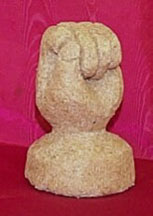Lesson Plan

Art Education
Lesson Plan

Subject/Title: Plaster and Vermiculite Carving
Grade Level: 5-12
Goal: To introduce students to a sculpture technique that involves the subtractive process of carving.
Objectives: Students will produce a carved sculpture.
Materials:
Plaster of Paris
Fine-textured vermiculite
Water, bowl, measuring container
32 oz. Styrofoam cups (to be used as molds)
Plastic knives
Gallon size plastic bags
Clear acrylic sealer
*Optional: shallow box, small plastic cups
Introduction:
Show examples of abstracted/non-objective art and have students notice the emphasis on shape and form. (Optionally, show examples of primitive sculptures.) Explain that students will be carving into a soft, crumbly material that is not especially suited to highly detailed work, and they must, therefore, plan simple designs.
Procedure:
1. Mix plaster, vermiculite and water according to these ratios: 3 parts vermiculite, 2 parts Plaster of Paris, 2+ parts water. Mix together dry ingredients in a large bowl or bucket. Add water, and let sit until it stops bubbling (a minute or two). Mix well with hands, squeezing out all the lumps. (If a quart measuring container is used, the ratio will be 3 qts. vermiculite, 2 qts. Plaster of Paris, 2 qts. + about 1/2 cup of water. This will yield four 32 oz. cup molds.)
2. After mixing, immediately pour into 32 oz. Styrofoam cups and tap sides of the mold to bring air bubbles to top.
3. Allow to harden (at least over night) and cover molds with plastic bags to keep fresh until ready for use. (If sealed in a gallon ziplock bag, this mixture will remain soft enough to carve for at least four weeks!)
4. When the mixture has hardened, carefully remove mold.
5. As the material is very soft and will still be very damp, a plastic knife is a good carving tool. When the work is finished for the day, return it to the plastic bag to keep it moist until the next class period.
6. Students may carve by setting the block inside of a shallow box (a copier paper box lid is ideal) as this will contain the mess. The carved material may then be dumped out in a trashcan OR it can actually be modeled with the hands to create another sculptural form.
7. Once the desired shape is achieved and the stray crumbs have been carefully brushed away, allow to dry. This may take several days, depending on the heat and humidity. As the work dries, it will become lighter in color, lighter in weight, and will no longer feel cold or damp to the touch.
8. Seal with one or two coats of acrylic sealer, and mount, if desired, on a wooden base.
Notes:
I had never tried using a mixture of plaster and vermiculite, and I found it to be very easy to work with. (Another big "THANK YOU" to the art teacher who shared this "recipe"!) Unlike pure plaster, which is very hard and can require special tools for carving, a plastic knife is all that is really needed to achieve good results.
I had some of my students first draw their ideas on paper and plan out what they were going to do before I allowed them to begin carving. (I was concerned that they would whittle away until there was nothing left!) However, I let other students to just jump in, and they did fine, too.
As I was not using a quart measuring container, I sometimes had small quantities of the mixture left over. I poured this into small plastic cups and used these as "starter" projects so that the students could get a feel for the material, the amount of pressure required to carve it, and the necessity of keeping to simple designs.
I didn't specify subject matter for this project (though it is very adaptable), as I mainly wanted them to experience a subtractive sculptural process. As a result, they have produced both abstracted human forms and non-objective pieces with interesting openings, twirls, and spirals that lead the eye over the work.
All students who worked on these commented that it required a very different type of thinking from the 2-D and additive sculpture projects that they'd done earlier. Many found this to be very challenging project, but most seemed to enjoy it. I'm pleased with their results.
